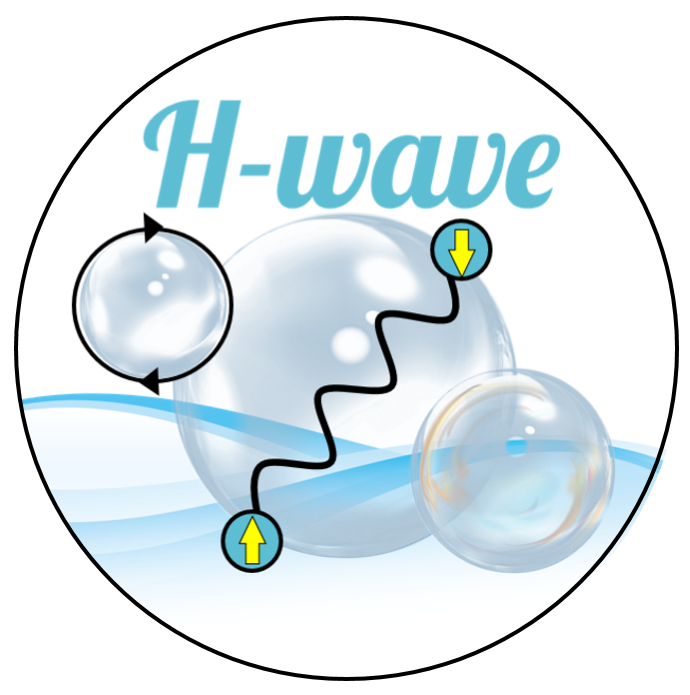Interaction definition files¶
The interaction definition files describe the coefficients \(T_{\alpha\beta}(r_{ij})\), \(J_{\alpha\beta}(r_{ij})\), \(V_{\alpha\beta}(r_{ij})\), or \(U_{\alpha}\) of the one-body and two-body Hamiltonian denoted by the following expressions. They are given in Wannier90(-like) format. It is noted that the generalized two-body interaction term (InterAll) is not supported in the wave-number space UHF.
- Transfer:
\(\sum_{ij\alpha\beta\sigma} T_{\alpha\beta}(r_{ij})\,c_{i\alpha\sigma}^{\dagger}c_{j\beta\sigma}^{\phantom{\dagger}}\)
- CoulombIntra:
\(\sum_{i\alpha} U_\alpha\,n_ {i\alpha\uparrow} n_{i\alpha\downarrow}, \quad (n_{i\alpha\sigma}=c_{i\alpha\sigma}^{\dagger}c_{i\alpha\sigma}^{\phantom{\dagger}})\)
- CoulombInter:
\(\sum_{ij\alpha\beta} V_{\alpha\beta}(r_{ij})\,n_{i\alpha} n_{j\beta}, \quad (n_{i\alpha}=n_{i\alpha\uparrow}+n_{i\alpha\downarrow})\)
- Hund:
\(\sum_{ij\alpha\beta} J_{\alpha\beta}^{\rm Hund}(r_{ij}) \left( n_{i\alpha\uparrow} n_{j\beta\uparrow} + n_{i\alpha\downarrow} n_{j\beta\downarrow} \right)\)
- Ising:
\(\sum_{ij\alpha\beta} J_{\alpha\beta}^{\rm Ising}(r_{ij}) S^{z}_{i\alpha} S^{z}_{j\beta}, \quad (S^{z}_{i\alpha}=\frac{1}{2}(n_{i\alpha\uparrow} - n_{i\alpha\downarrow}))\)
- PairHop:
\(\sum_{ij\alpha\beta} J_{\alpha\beta}^{\rm PH}(r_{ij})\,c_{i\alpha\uparrow}^{\dagger} c_{j\beta\uparrow}^{\phantom{\dagger}} c_{i\alpha\downarrow}^{\dagger} c_{j\beta\downarrow}^{\phantom{\dagger}} + \textit{h.c.}\)
- Exchange:
\(\sum_{ij\alpha\beta} J_{\alpha\beta}^{\rm Ex}(r_{ij})\,c_{i\alpha\uparrow}^\dagger c_{j\beta\uparrow}^{\phantom{\dagger}} c_{j\beta\downarrow}^\dagger c_{i\alpha\downarrow}^{\phantom{\dagger}}\)
- PairLift:
\(\sum_{ij\alpha\beta} J_{\alpha\beta}^{\rm PairLift}(r_{ij})\,c_{i\alpha\uparrow}^{\dagger} c_{i\alpha\downarrow}^{\phantom{\dagger}} c_{j\beta\uparrow}^{\dagger} c_{j\beta\downarrow}^{\phantom{\dagger}}\)
An example of the file is shown below.
wannier90 format for vmcdry.out or HPhi -sdry
10
245
1 1 1 1 1 1 1 1 1 1 1 1 1 1 1
1 1 1 1 1 1 1 1 1 1 1 1 1 1 1
...
1 1 1 1 1
-3 -3 -2 1 1 -0.0000269645 -0.0000000000
-3 -3 -2 1 2 -0.0000071722 -0.0000018600
-3 -3 -2 1 3 -0.0000083990 0.0000010972
-3 -3 -2 1 4 -0.0000000990 0.0000000427
-3 -3 -2 1 5 -0.0000018628 -0.0000003609
-3 -3 -2 1 6 -0.0000129504 -0.0000014047
-3 -3 -2 1 7 -0.0000189169 0.0000024697
-3 -3 -2 1 8 0.0000238115 0.0000014316
-3 -3 -2 1 9 0.0000036708 -0.0000003266
-3 -3 -2 1 10 0.0000361752 0.0000003247
-3 -3 -2 2 1 -0.0000071722 0.0000018600
-3 -3 -2 2 2 0.0000105028 -0.0000000000
...
File format¶
Line 1: Header
Line 2:
[Norbit]Line 3:
[Npts]Lines 4 - \(\lceil N_\text{pts} / 15 \rceil + 3\):
[n1] [n2] ...Line \(\lceil N_\text{pts} / 15 \rceil + 4\) onwards:
[rx] [ry] [rz] [alpha] [beta] [J.real] [J.imag]
Parameters¶
[Norbit]Type : Integer
Description : This parameter specifies the number of orbitals \(N_\text{orbit}\) in a unit cell.
[Npts]Type : Integer
Description : This parameter specifies the number of cells in a rectangular cuboid that accommodates entire translation vectors.
[n1],[n2], …Type : Integer
Description : These parameters specify the multiplicity of cells (ordinary 1), with 15 points in a line.
[rx],[ry],[rz]Type : Integer
Description : These parameters specify the translation vector.
[alpha],[beta]Type : Integer
Description : These parameters specify the indices of the orbitals.
[alpha]corresponds to the orbital \(\alpha\) in the original cell, and[beta]corresponds to the orbital \(\beta\) in the cell displaced by \(\vec{r}\).[J.real],[J.imag]Type : Float
Description : These parameters specify the real and imaginary parts of the coefficient \(J_{\alpha\beta}(\vec{r})\).
Usage rules¶
Header cannot be omitted.
The unspecified elements of the coefficient matrix are assumed to be zero.
The translation vectors need to be enclosed within the CellShape. If the range of
r_x,r_y, orr_zexceeds the extent ofx,y, orzdimension of CellShape, the program terminates with an error.When
mode.enable_spin_orbitalis set totrue, the orbital indices of Transfer term are interpreted as the extended orbital indices including spin degree of freedom that ranges from 1 to \(2 N_\text{orbital}\), in which the indices \(1 \dots N_\text{orbital}\) correspond to spin-up, and the indices \(N_\text{orbital}+1 \dots 2N_\text{orbital}\) correspond to spin-down. Otherwise, only the entries with the orbital indices from 1 to \(N_\text{orbital}\) are taken into account.
